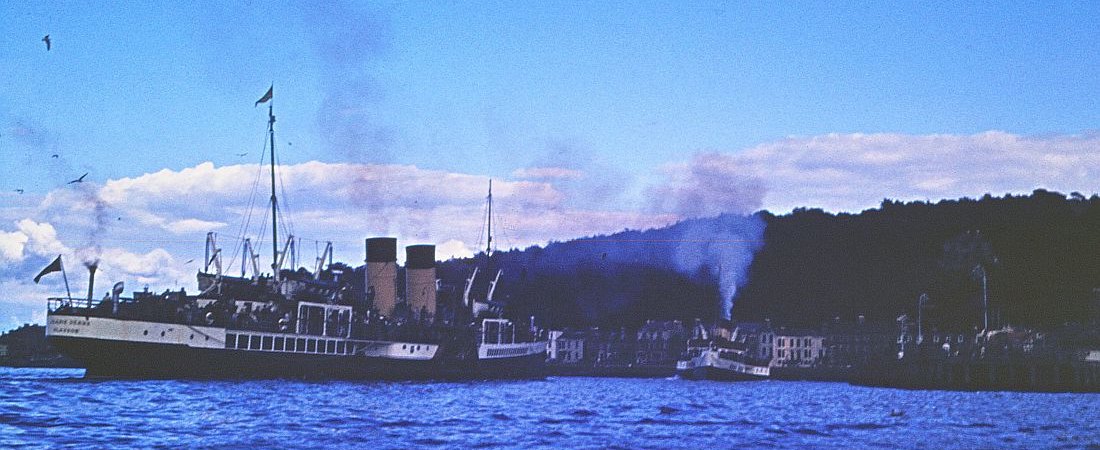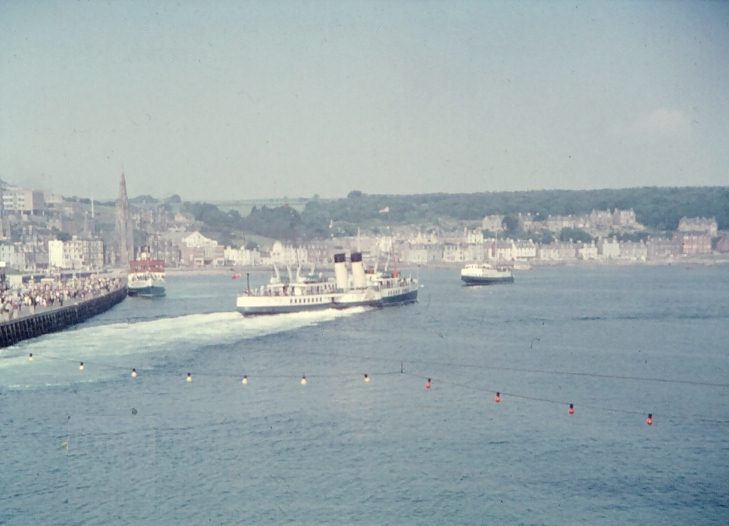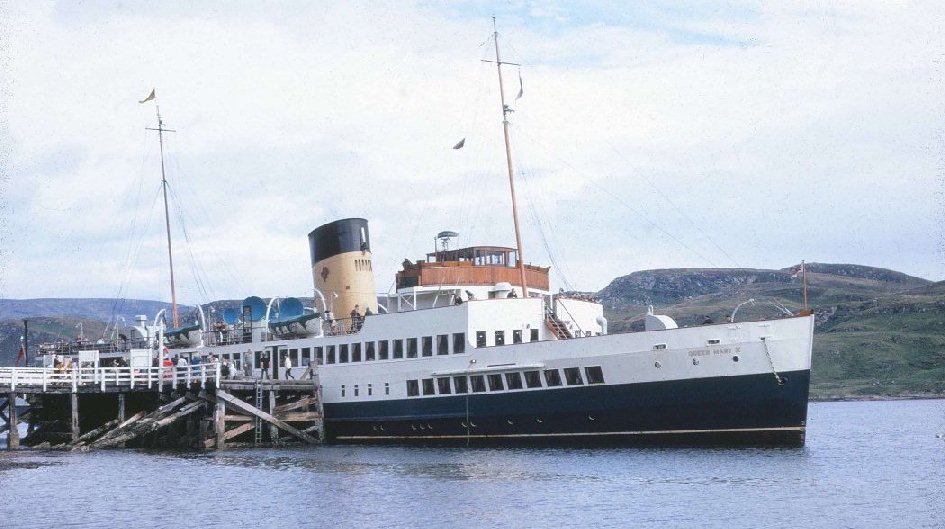
paddlesteamers.info : The Internet's leading website for Side-Wheeled Paddle Steamers
Special Report : CLYDE STEAMERS IN THE 1960s : By Gordon Stewart
For a full review of Clyde paddle steamers and their operators, with individual vessel pages : Click here
More details about the Turbine Steamers can be found on our associated website : Click hereRead Gordon Stewart's review of the new Clyde Steamers of the 1930s - most of which had their swansong in the 1960s : Click here
For details of paddle steamers worldwide, past and present, return to the main database homepage
Only this time, the 223'6" (68.1 m) long,
twin-funneled paddler was not resplendent in fresh paintwork - black hull,
white deckhouses and yellow funnels with black top - and freshly varnished
teak-clad wheelhouse and bridge. There was no sign of the plumes of white
steam mixed in with the black smoke from boilers stuttering into operation
after months of winter inactivity. The familiar beat of paddle wheels against
the waters of the Firth was disconcertingly absent and the bright white froth
of disturbed water raking out behind the paddles either side of the ship was
also not to be seen. "Jupiter" was not moving the couple of miles along
the Renfrewshire coast to position herself at the nearby Gourock railhead
to load passengers off the latest train from Glasgow eager to take in
the fresh sea air as they crossed to the Cowal Peninsula or the Isle of
Bute. She was under tow, her destination was Dublin and the ownership of
the Hammond Lane Foundry Company which had bought her from a Belfast
merchant and whose only interest was the scrap value of her steel hull and boiler
plates, alloy engine parts and brass fittings.
These last, sad, journeys
occurred with inevitable regularity as old tonnage gave way to new, and
"Jupiter" herself had entered service after a number of older Clyde
favourites had been withdrawn from service, an earlier "Jupiter" amongst
them. This time, however, the funeral procession was for a ship only 24
years old - a mere youngster in Clyde steamer terms, having completed only 15
seasons, and there was no new state-of the-art vessel waiting to assume her
role.
Many enthusiasts were dismayed as "Jupiter" was left in her winter
lay-up dock at Greenock when the 1958 season reopened, especially as she had
been converted, at considerable expense, to burn oil fuel during the
previous winter. Most thought that it was a temporary economy measure. When
she was sold out of the fleet in May 1960, only the most pessimistic, or
perhaps more accurately, the most perceptive, recognised that times were
changing once and for all. By 1970, the situation on the Clyde was to be
vastly different from the opening year of the decade of flower
power.
No new paddle steamer had entered service since 1947. This had
been the "Waverley", rather hastily ordered by the London & North Eastern
Railway to replace "Marmion" which had been lost during World War II, and
maintain the company's prestige service up Loch Long to Arrochar. This
long-established service had lost its original raison-d'etre once the railway
had reached the area and a road had been built along the steep-sided loch,
but generated a reasonable amount of traffic as it was one stage in the popular "Three Lochs Tour" by which the homebound
leg included a cruise on Scotland's most famous lake, Loch Lomond. The
LNER stuck to traditional technology and kept to paddle propulsion
partially through innate conservatism, but primarily due to draught
restrictions at their home base at Craigendoran.
The 1950s had seen
the progressive withdrawal of many of the much-loved steamers which had
survived the rigours of the Second World War. In 1953, four motor vessels,
the "Maids" of Ashton, Argyll, Skemorlie and Cumbrae were put into service on
the upper Clyde. Fitted with diesel engines
and much smaller than the ships they replaced, they did at least help
to reduce the
operating costs which were beginning to overwhelm
the Caledonian Steam Packet Company, under whose control the entire "Clyde
Steamer" fleet had by then become. Even more significantly, the following
year saw the introduction of three car ferries, "Arran", "Bute" and "Cowal",
also diesel-powered.
Their names hinted that these three most important destinations would, in
future, be served by dedicated car (and lorry) carriers to ease the flow of
goods to these remote communities, but also to recognise that visitors now
wanted to take their cars to the islands and islanders wanted to do the
reverse. From this point on, the importance of fast and efficient
point-to-point ferries became clear and set the direction for the service
pattern we see today.
With the car ferries and the "Maids" in service, it
was inevitable that there would soon be no place for "Jupiter". The paddler had
not been designed for full-day excursion cruise work and although she had visited
the lochs of the upper Firth during her final seasons, was not deemed
suitable to displace any of the existing fleet. Purists were horrified, but accountants delighted and
for most travellers, the ability take one's car at significantly less inconvenience
than previously was a distinct advantage of the new regime. The boost to businesses on
Cowal and the islands was particularly welcomed as freight transport was revolutionised. Demand for car ferry
services was beginning an accelerating upward trend.
The
1960 summer season saw the Firth of Clyde covered by a maze of routes :
point-to-point ferries, inter-resort services on the upper Clyde,
long-distance routes to the furthest-flung corners of the Firth, and a
dedicated cruise ship based at both Glasgow and Ayr. The old
steamers still had a role, especially in the main summer season where
there remained a good demand for day sails and where they could help
out on the point-to-point ferry routes at times of peak demand. The
paddlers "Jeanie Deans", "Caledonia", "Waverley" and the
diesel-powered "Talisman" sailed alongside the turbine steamers "Duchess of
Montrose" (the oldest vessel at 30 years of age), "Duchess of Hamilton" and
"Queen Mary II". "King George V",
similar in design to the Caledonian's turbines, was also seen on the
Clyde from time to time on David McBrayne's route to Ardrishaig
transporting mail for the western Isles which was usually the preserve
of the diesel-electric MV Lochfyne. It was still possible, if one so
wished, to buy a day rover ticket, work out ingenious
itineraries, visit numerous piers and by studying the timetable
closely, sail on a number of traditional steamers in the one day.
The 1960s was a decade of
change in many parts of British society, and the new trend towards taking
foreign "package" holidays was just one sign of growing wealth and changing
tastes - one which was to finally relegate excursion cruising from the
mainstream. The number of
pure excursionist passengers had been falling since the post-war peak year,
1955, but it took some dreadfully cold and wet summers in the early part of
the "sixties" to underline the inevitable trend. The Caledonian Steam
Packet Company, desperately trying to stem its losses, took the necessary but dismaying step of
retiring
two top favourite vessels after the 1964 season. Paddler "Jeanie Deans" of
1931 had been highly popular running from Craigendoran to Rothesay and the
Kyles of Bute, whilst the turbine "Duchess of Montrose" of 1930 was possibly
the most-loved of all cruise steamers. Her shock withdrawal signalled a
severe thinning of the services to Campbeltown and Inveraray, the
far-flung destinations in Argyll which the "Montrose" and sister-ship
"Duchess of Hamilton" had made their own.

Above : 1964 : The final year for the two "Craigendoran paddlers"
sailing together : Jeanie Deans (left) is in her final season as
she approaches Rothesay. Just departing is Waverley, which had a
number of years left ..............and as fate turned out, far more
than anyone could have possibly imagined. Photo by Ian Stewart.
With "Jeanie Deans" laid up,
"Caledonia", which had been the Ayr-based excursion steamer, moved north to
Craigendoran to take her place. A vessel originally attached to the London,
Midland & Scottish Railway was, for the first time, based at the old
headquarters of the London & North Eastern Railway and the intense
competition between the two which had raged right up until 1948 was now a
distant memory. For many of Jeanie's fans and enthusiasts for the old LNER services,
the appearance of "Caledonia" at the north bank pier was nevertheless
hard to stomach. Ayr, the largest resort on the mainland and far enough away
from the upper Firth to justify its own dedicated cruises, was now left
without a resident vessel and steamer calls of any sort became very
infrequent.
The Clyde, with its maze of sea channels and fjord-like lochs
close to a large population centre was the last bastion for such vessels in
Britain. The Bristol Channel, the Solent and the Thames Estuary, other
traditional coastal excursion areas, were suffering the same problems as the
Clyde and were reducing their fleets earlier and faster than was happening
further north. There were no buyers for the redundant vessels. "Duchess
of Montrose" left under tow to Belgian breakers at Gent in August of 1965
and it was assumed that "Jeanie Deans" would follow soon
afterwards. Fortunately, a group of London-based enthusiasts, having seen
the decimation of their local fleet, took it upon themselves to operate her
on the Thames and in November 1965 she left Greenock for the journey
south. The venture was dogged by mechanical problems with "Queen of the
South" as Jeanie Deans had been renamed, and the Coastal Steam Packet Company
folded with the ship leaving for Antwerp breakers two days after Christmas
in 1967. The jury was therefore out on whether an excursion ship could be
run as a going concern. What was definitely known was that if it was,
it needed to be adequately financed and professionally operated :
lessons which had to be learnt quickly when the axe was to fall on her former
LNER fleetmate, "Waverley" not too long afterwards.
In the
meantime there was "retrenchment" on the Clyde whilst an inexorable decline in
excursion passengers numbers took hold and costs continued to rise. No longer
was fuel cheap, although conversions to oil from coal during the 1950s helped
to minimise the increases, and wage costs were no longer at the low levels which
steamer operators had been able to "get away with" before World War
II. Attempts to raise revenue through increased fares inevitably met with vigorous public
protest and any rises achieved
never fully covered the rising costs. No money was generated for new investment
although this was desperately needed in the one growing segment
in the market - their car ferry services, which were becoming increasingly
stretched and unreliable.
The CSP had little option other than to reduce their passenger-only services even
further.
The
diesel paddler "Talisman", which had carved out a successful career (initially
against all odds) on the Wemyss Bay - Largs - Millport (Isle of Cumbrae) run,
was taken out of service at the end of the 1966 season to be replaced by a
much smaller motor vessel, "Keppel" which had previously operated the short
River Thames crossing at Tilbury under the name "Rose". "Keppel" was no
pleasure to sail on, even in comparison to "Talisman" which had a reputation
for excessive vibration, being diesel powered rather than steam powered as
the other paddlers were. However, at least a service was maintained to the
island of Cumbrae until new investment in the 1970s enabled the inauguration of a
roll-on roll-of car ferry service.
|
|
|
In September 1969, when Nigel Lawrence took these photos of Waverley (above),
she was not the last paddle steamer in the Clyde fleet - but within
weeks she was .................
It was approaching the end of
the season and there are still plenty of passengers aboard - but
not enough for the new masters of the Caledonian Steam Packet Company
and "retrenchment" was the inevitable consequence.
"Caledonia" was the next to go -
at
the end of the 1969 season. She was sold to Arnott, Young shipbreakers at
nearby Dalmuir, where "Talisman" had earlier met her fate. Fortunately, she
was resold to the brewery company Bass-Charrington and began a new life as a
statically moored pub in central London, lasting until gutted by fire in
1980.
In 1969, the Caledonian Steam Packet Company was removed from its
link to railway industry and became part of the Scottish Transport Group,
a state-owned entity dominated by bus operators. This signalled the
final break with the traditional role of providing the last leg of
railway passengers' journey to the coast and heralded a new era of providing
a "road bridge" across the Firth. A Swedish roll-on roll-off ferry,
"Stena Baltica" was brought to the Clyde and although not an ideal vessel,
she was revolutionary for her new environment and provided much-needed
extra capacity on the Arran run. As a sign of changing times, she was given
the name "Caledonia" and her unusual appearance caused even more of a stir
than her "streamlined" predecessor had invoked in 1934. It was now 17
years since a passenger-only vessel had been delivered new to the Clyde, and
12 since any new tonnage of any sort had been delivered -
and even one of the "Maids", also now struggling to justify their
existence, was soon to be sent for reconstruction as a car ferry whilst
new purpose-built tonnage was put on order.
The 1960s had been a
decade of hope in a technology-led future, despite it being one of remarkable
stagnation for the Clyde. The old ways were being left behind and the vessels
from the steam era were disappearing fast. Only one out of four
paddlers ("Waverley" of
1947) and two of three Clyde turbines ("Duchess of
Hamilton" of 1932 and "Queen Mary II" of 1933) survived the turbulent decade
whilst . "King George V" remained on station at Oban. A small
band of British enthusiasts had formed the Paddle Steamer Preservation Society
and hoped, with a great feeling of helplessness, to delay the inevitable. Not
only had paddle steamers now almost disappeared, but as the "sixties"
ended, the days of the "Clyde Steamers" were also almost
over..........................
Footnote :
TS Duchess of Hamilton
survived only until the end of the 1970 season and was scrapped after a
failed attempt to save her as a restaurant.
PS Waverley was sold
in 1974
but survives in operation, owned and operated on behalf of the Paddle Steamer
Preservation Society.
TS Queen Mary
lasted until late in 1977, eventually replaced Caledonia in London as a
pub / restaurant / night club until 2009. She is now back at Glasgow
and under reconstruction, initiallyplanned as a static heritage
attraction but after an announcement by HRH the Princess Royal in 2022,
plan are being made to return her to passenger service.
When Waverley was withdrawn after the 1973 season, two young
Paddle Steamer Preservation Society members made one of the most momentous decisions
ever - for the Society to take ownership and return her to active service. Almost
everyone believed that this plan was doomed to failure - and it almost did fail
- but it became one of the most remarkable campaigns in maritime history.
Follow
the story onwards...............
ROTHESAY PIER IN THE LATE 1960s

Above : Crowds line Rothesay
pier as the paddle steamer Waverley draws away and one of the "Maid"
class passenger motor vessels awaits her berth. Already at the pier
is the turbine steamer Duchess of Hamilton.
Three major passenger-only
vessels, two in steam. A scene which was soon to come to an end.
Waverley still calls at Rothesay, but will generally only meet one
of the car ferries which link the resort with Wemyss Bay on the
mainland. This photo by Alexander Bain kindly supplied by Donald
Bain magnificently captures the end of an era on the Clyde.
ASSOCIATED WEBSITE : THE CLYDE TURBINE STEAMERS

The paddlesteamers.info database includes detailed information
about the fleet of paddle steamers on the Firth of Clyde in Scotland.
However, no analysis of excursion shipping operations is complete
without reference to the fleet of magnificent turbine steamers which,
from 1901, sailed alongside the paddlers. That year saw the introduction
of TS King Edward, the world's first ever turbine powered passenger
steamer. Wm Denny and Bros, the Dumbarton shipbuilder produced this
fine vessel and went on to deliver many more, especially for short
sea ferry operations. One of their most famous was the Clyde Steamer
Queen Mary of 1933 (above, in photo taken at Tighnabruaich in 1967
by Jake Dale) which sailed for most of its life as
Queen Mary II, having lent its name to the Cunard liner which
was launched in 1934.
Turbine steamers dominated the world's
seas for many years, but found little success in coastal or lake
ferries, and in this respect, the fleet on the Clyde is unique.
The Clyde Turbine Steamers website aims to remember these magnificent
ships and support anyone who looks after the last survivor, Queen
Mary, which was withdrawn from service in 1977 but remains in static
use. Queen Mary is the last of her class worldwide and one of the
few passenger turbine steamers of any class worldwide. The
website looks at the Clyde turbines in detail and Queen Mary in
particular
TS Queen Mary, until January 2009 a floating restaurant in London, was the flagship of the Caledonian Steam Packet Company until her withdrawal in 1977. In September 2015 she was obtained by a Scottish charity whose objects are to preserve this vessel, now unique in the world and with a fascinating back-story, in her original home port of Glasgow. The charity now needs as much support as possible to ensure she is preserved and cared for - for the benefit of the nation and the Clyde's maritime heritage
Go to : Clyde Turbine Steamers